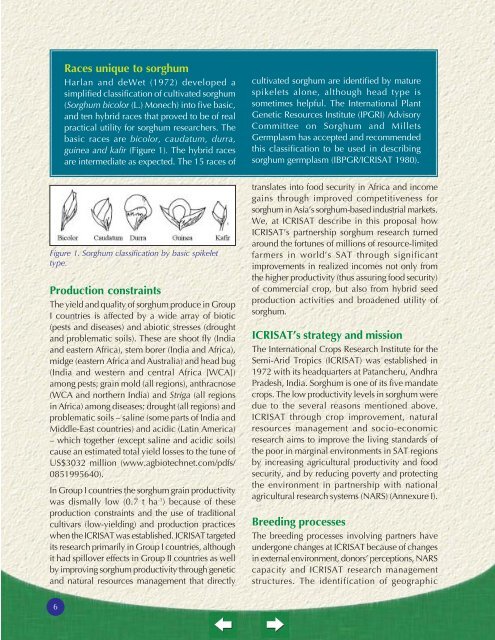Sorghum - icrisat
Sorghum - icrisat
Sorghum - icrisat
Create successful ePaper yourself
Turn your PDF publications into a flip-book with our unique Google optimized e-Paper software.
Races unique to sorghum<br />
Harlan and deWet (1972) developed a<br />
simplified classification of cultivated sorghum<br />
(<strong>Sorghum</strong> bicolor (L.) Monech) into five basic,<br />
and ten hybrid races that proved to be of real<br />
practical utility for sorghum researchers. The<br />
basic races are bicolor, caudatum, durra,<br />
guinea and kafir (Figure 1). The hybrid races<br />
are intermediate as expected. The 15 races of<br />
Figure 1. <strong>Sorghum</strong> classification by basic spikelet<br />
type.<br />
Production constraints<br />
The yield and quality of sorghum produce in Group<br />
I countries is affected by a wide array of biotic<br />
(pests and diseases) and abiotic stresses (drought<br />
and problematic soils). These are shoot fly (India<br />
and eastern Africa), stem borer (India and Africa),<br />
midge (eastern Africa and Australia) and head bug<br />
(India and western and central Africa [WCA])<br />
among pests; grain mold (all regions), anthracnose<br />
(WCA and northern India) and Striga (all regions<br />
in Africa) among diseases; drought (all regions) and<br />
problematic soils – saline (some parts of India and<br />
Middle-East countries) and acidic (Latin America)<br />
– which together (except saline and acidic soils)<br />
cause an estimated total yield losses to the tune of<br />
US$3032 million (www.agbiotechnet.com/pdfs/<br />
0851995640).<br />
In Group I countries the sorghum grain productivity<br />
was dismally low (0.7 t ha -1 ) because of these<br />
production constraints and the use of traditional<br />
cultivars (low-yielding) and production practices<br />
when the ICRISAT was established. ICRISAT targeted<br />
its research primarily in Group I countries, although<br />
it had spillover effects in Group II countries as well<br />
by improving sorghum productivity through genetic<br />
and natural resources management that directly<br />
cultivated sorghum are identified by mature<br />
spikelets alone, although head type is<br />
sometimes helpful. The International Plant<br />
Genetic Resources Institute (IPGRI) Advisory<br />
Committee on <strong>Sorghum</strong> and Millets<br />
Germplasm has accepted and recommended<br />
this classification to be used in describing<br />
sorghum germplasm (IBPGR/ICRISAT 1980).<br />
translates into food security in Africa and income<br />
gains through improved competitiveness for<br />
sorghum in Asia’s sorghum-based industrial markets.<br />
We, at ICRISAT describe in this proposal how<br />
ICRISAT’s partnership sorghum research turned<br />
around the fortunes of millions of resource-limited<br />
farmers in world’s SAT through significant<br />
improvements in realized incomes not only from<br />
the higher productivity (thus assuring food security)<br />
of commercial crop, but also from hybrid seed<br />
production activities and broadened utility of<br />
sorghum.<br />
ICRISAT’s strategy and mission<br />
The International Crops Research Institute for the<br />
Semi-Arid Tropics (ICRISAT) was established in<br />
1972 with its headquarters at Patancheru, Andhra<br />
Pradesh, India. <strong>Sorghum</strong> is one of its five mandate<br />
crops. The low productivity levels in sorghum were<br />
due to the several reasons mentioned above.<br />
ICRISAT through crop improvement, natural<br />
resources management and socio-economic<br />
research aims to improve the living standards of<br />
the poor in marginal environments in SAT regions<br />
by increasing agricultural productivity and food<br />
security, and by reducing poverty and protecting<br />
the environment in partnership with national<br />
agricultural research systems (NARS) (Annexure I).<br />
Breeding processes<br />
The breeding processes involving partners have<br />
undergone changes at ICRISAT because of changes<br />
in external environment, donors’ perceptions, NARS<br />
capacity and ICRISAT research management<br />
structures. The identification of geographic<br />
6
















